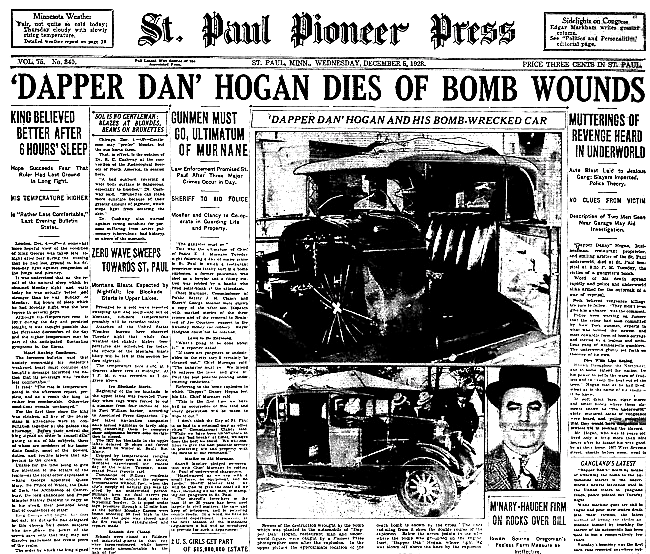'Dapper Dan' Hogan – a go-between for criminals and corrupt cops – died Dec. 4, 1928
From the Archives: St. Paul gangster killed by car bomb
Provided to the Saint Paul Police Historical Society by reporter Nick Woltman.
Originally printed in the St. Paul Pioneer Press on Saturday, December 05, 2015
By Nick Woltman
nwoltman@pioneerpress.com

Saint Paul Pioneer Press; Vol. 75, No. 340
Wednesday, December 5, 1928
Price Three Cents
Shortly before noon on Dec. 4, 1928, residents of "Dapper Dan" Hogan's West Seventh Street neighborhood were startled by an explosion in the St. Paul gangster's garage.
A bomb beneath the floorboards of his car blew off Hogan's right leg when he pressed the starter, leaving him fatally injured. Hogan was well-known in St. Paul as a restaurateur and philanthropist -- and as a powerful figure in the city's Prohibition-era underworld, acting as a go-between for criminals and corrupt cops.
News of Hogan's assassination led the front page of the next day's Pioneer Press. A photo of his destroyed car was marked with an "X" where the bomb detonated. Detectives told the St. Paul Dispatch that "the blast had hurled Mr. Hogan's body up with such force that his head broke through the top" of the car.
Hogan, 48, was rushed to a St. Paul hospital, where dozens of friends and fellow gangsters turned out to donate blood in hopes of improving his chances of survival, the city's newspapers reported. Assistant Ramsey County Attorney Edward Diehl questioned Hogan at his bedside.
"I don't know who did it," Hogan told Diehl, according to the Pioneer Press. "I didn't know I had an enemy in the world."
Police and fellow criminals floated several theories to reporters, including rival locals and out-of-towners who were bitter about being forbidden from operating in St. Paul.
Hogan was the arbiter of the city's infamous Layover Agreement, which allowed criminals from around the country to lie low in St. Paul while they were on the lam as long as they behaved while they were in town, according to local crime historian Paul Maccabee's book "John Dillinger Slept Here."
Hogan died at 8:55 that evening, about nine hours after the explosion. The Pioneer Press editorial board feared his death would touch off a gang war and "make St. Paul a shooting gallery." Local newspapers called for city officials to oust the criminals and institute law and order.
"St. Paul has been a sanctuary for the underworld long enough," read an editorial in the next day's Pioneer Press. "This city cannot continue to be a safe haven for crooks, professional gamblers, gun men and breakers of law."
But it did continue. After Hogan died, his protege Harry Sawyer took control of Hogan's criminal enterprise. Although the case remains unsolved, Maccabee calls Sawyer, who harbored much resentment toward his boss over unpaid debts, "the most credible murder suspect."
Nick Woltman writes about St. Paul history on his From the Archives blog at http://blogs.twincities.com/fromthearchives. He can be reached at 651-228-5189. Follow him at twitter.com/PiPressArchives.
